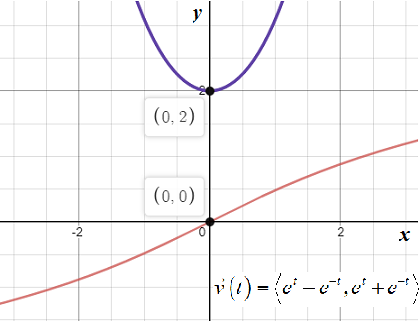
(a)
To calculate: The velocity
(a)
Answer to Problem 38E
The required velocity and speed of the particle are
Explanation of Solution
Given information:
The position vectors:
Calculation:
Consider the position vector be
So,
It is known that for a position vector
So,
Hence, the required velocity is
(b)
To calculate: The value of
(b)
Answer to Problem 38E
The required value of
Explanation of Solution
Given information:
The position vectors:
Calculation:
Consider the position vector be
So,
Here,
Also,
Now, substitute
Hence, the required value of
(c)
To prove: Algebraically that the particle moves on the hyperbola
(c)
Explanation of Solution
Given information:
The position vectors:
Calculation:
Consider the position vector be
So,
Substitute
Thus, left hand side = right hand side
Hence, it is proved that the particle moves on the hyperbola
(d)
To graph: The path of the particle and showing the velocity vector at
(d)
Explanation of Solution
Given information:
The position vectors:
Calculation:
Consider the position vector be
So,
It is known that for a position vector
So,
Substitute 0 for t in the above expression.
The graph of the path of the particle is shown below:

Chapter 11 Solutions
Calculus 2012 Student Edition (by Finney/Demana/Waits/Kennedy)
Additional Math Textbook Solutions
College Algebra (7th Edition)
Calculus: Early Transcendentals (2nd Edition)
Elementary Statistics
Elementary Statistics: Picturing the World (7th Edition)
A Problem Solving Approach To Mathematics For Elementary School Teachers (13th Edition)
Basic Business Statistics, Student Value Edition
- Solve : X + sin x = 0. By the false positioning numerical methodarrow_forwardSolve: X + sin X = 0 by the false positionining numerical methodarrow_forwardOn from the equation: 2 u = C₁ + C₂ Y + Czy + Cu y³ Find C₁, C₂, C3 and Cy Using these following Cases : (a) 4=0 at y=0 (b) U = U∞ at y = 8 du (c) at Y = S ду --y. ди = 0 at y = 0 бугarrow_forward
- Tips S ps L 50. lim x2 - 4 x-2x+2 51. lim 22 - X 52. 53. x 0 Answer lim x 0 lim 2-5 X 2x2 2 x² Answer -> 54. lim T - 3x - - 25 +5 b+1 b3b+3 55. lim X x-1 x 1 Answer 56. lim x+2 x 2 x 2 57. lim x²-x-6 x-2 x²+x-2 Answer-> 23-8 58. lim 2-22-2arrow_forwardS 36. lim 5x+2 x-2 37. lim √√2x4 + x² x-3 Answer-> 2x3 +4 38. lim x12 √ x² + 1 √√x² + 8 39. lim x-1 2x+4 Answer 40. lim x3 2x x√x² + 7 √√2x+3arrow_forwardSee imagearrow_forward
- Enter your answer in interval notation. No decimal entries allowed. Type oo (lower case o) for ∞ and -oo for -∞ if needed. Domain: Question Help: Message instructorarrow_forwardWrite a formula for the function g that results when the graph of the function f(x) = = 4 X is reflected about the y-axis, horizontally compressed by a factor of 2, shifted 7 units left, reflected about the x-axis and shifted 3 units up. g(x): = Question Help: Message instructorarrow_forwardQuestion 7 4 pts 1 Details The value of China's exports of automobiles and parts (in billions of dollars) is approximately f(x) = 1.8208e0.3387x, where x = 0 corresponds to 1998. In what year did/will the exports reach $10.4 billion?arrow_forward
 Calculus: Early TranscendentalsCalculusISBN:9781285741550Author:James StewartPublisher:Cengage Learning
Calculus: Early TranscendentalsCalculusISBN:9781285741550Author:James StewartPublisher:Cengage Learning Thomas' Calculus (14th Edition)CalculusISBN:9780134438986Author:Joel R. Hass, Christopher E. Heil, Maurice D. WeirPublisher:PEARSON
Thomas' Calculus (14th Edition)CalculusISBN:9780134438986Author:Joel R. Hass, Christopher E. Heil, Maurice D. WeirPublisher:PEARSON Calculus: Early Transcendentals (3rd Edition)CalculusISBN:9780134763644Author:William L. Briggs, Lyle Cochran, Bernard Gillett, Eric SchulzPublisher:PEARSON
Calculus: Early Transcendentals (3rd Edition)CalculusISBN:9780134763644Author:William L. Briggs, Lyle Cochran, Bernard Gillett, Eric SchulzPublisher:PEARSON Calculus: Early TranscendentalsCalculusISBN:9781319050740Author:Jon Rogawski, Colin Adams, Robert FranzosaPublisher:W. H. Freeman
Calculus: Early TranscendentalsCalculusISBN:9781319050740Author:Jon Rogawski, Colin Adams, Robert FranzosaPublisher:W. H. Freeman
 Calculus: Early Transcendental FunctionsCalculusISBN:9781337552516Author:Ron Larson, Bruce H. EdwardsPublisher:Cengage Learning
Calculus: Early Transcendental FunctionsCalculusISBN:9781337552516Author:Ron Larson, Bruce H. EdwardsPublisher:Cengage Learning





